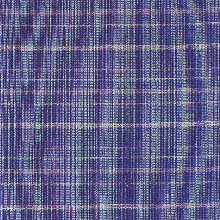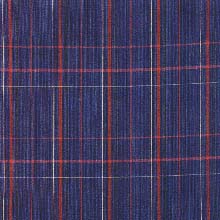Weave (p. 120 )
1. Produced in Takamatsu City, Tokushima Prefecture.
2. Characteristics: Cotton crepe, pre-dyed and crimpy. Crimps are created with the tension between the warp and weft. The indigo looks fresh and the touch is soft. It is inexpensive.
3. Uses: Clothes for summer, western clothes, small articles.
4. History: This cotton fabric was a result of improvement made on the traditional "Tatae Jima(stripe)" which had been woven in this area since the middle of the Edo Period. The Tatae Jima was woven in every home for their summer clothes. The story goes that a woman happened to find a Tatae Jima cloth which changed into a crimp like crepe when it was drenched by rain on a summer day. Following that incident, she produced a new fabric which was given the name "Awa Shijira (crimp)" in 1969. The threads are dyed in indigo then hand woven. The market for that fabric grew and its expansion was enjoyed with a great amount of production, once as much as 2 million "tan" a year. However, the production ceased in 1937 as it was affected by the production of other fabrics which advanced into the market and also by the outbreak of war that year. Although the production was revived in 1951, it decreased after 1973 due to little demand for traditional Kimono cloths. To the present day, the Awa Shijira is designated as an Important Intangible Cultural Property of Tokushima Prefecture as an indigo dyed folk craft fabric. The woman, Hana Kaifu, who invented the Awa Shijira, was conferred a Medal for Distinguished Invention by the Ministry of Agriculture and Commerce in 1883.




